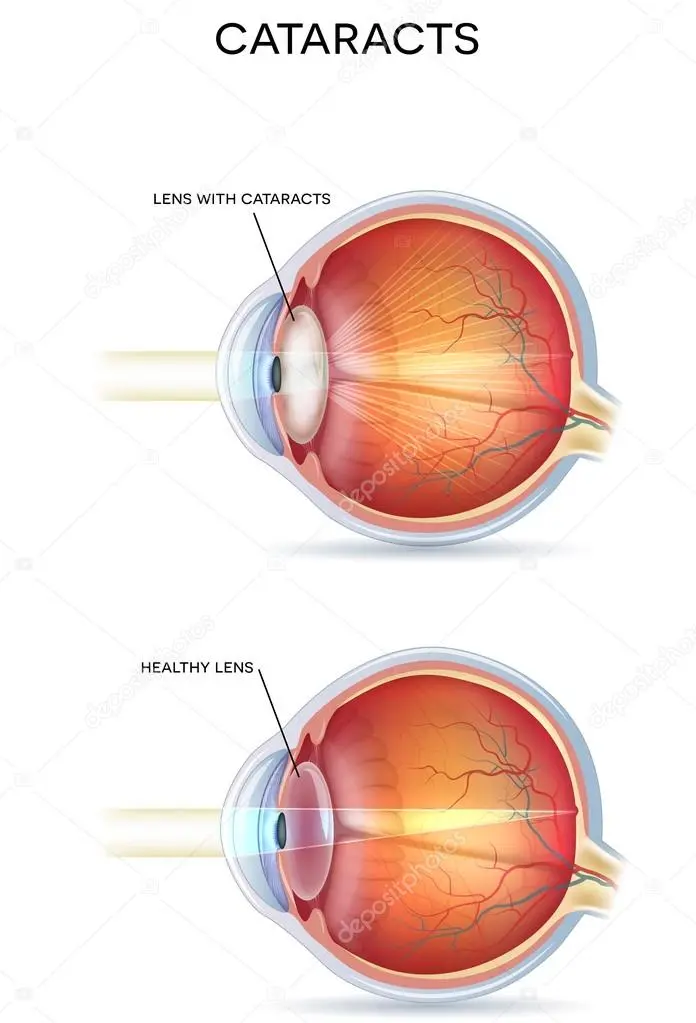Symptoms and Treatment of Cataracts
June 18, 2018

This month is Cataract Awareness Month. A cataract is the clouding of the natural lens of your eye causing blurry vision and other symptoms such as glare.
Cataracts are very common and usually occur as we age, but can occur in younger patients and is not at all uncommon.
The lens of your eye is located behind the iris (the colored portion of your eye). The lens helps in focusing images onto your retina.
The most common cause of cataracts is age-related, but aging is not the only cause.
Some cataracts are congenital, meaning they are present at birth. All newborns should have eye exams and a red reflex test. That test is recommended by the American Academy of Pediatrics and it is used to detect eye problems that may require immediate treatment. Congenital cataracts can be removed surgically.
Trauma is another cause. A cataract can form after a blunt force or a penetrating eye injury and occur after eye trauma because the fibers in the lens are damaged during the trauma.
Patients with certain diseases, such as diabetes, may get cataracts at an earlier age.
Cataract Symptoms
Most symptoms develop slowly. You may notice and a cloud, blur, or dim your vision or even halos to appear around lights. One or both eyes may develop cataracts and if you have cataracts in both eyes, the progression may vary in each eye.
There are three types —posterior subcapsular, nuclear, and cortical - none is better or worse than the other. A posterior subcapsular cataract forms under the lens capsule. This type of cataract causes glare or halos around lights at night and can also reduce vision in bright light.
A nuclear type forms in the nucleus of the lens. The nucleus is the center of the lens. If the cataract is only clouding this center portion, then it is termed a nuclear cataract. Nuclear cataracts tend to make the patient more near-sighted.
Cortical cataracts develop on the outer layer of the lens. Common symptoms of cortical cataracts and posterior-subcapsular cataracts also include glare and halos around lights at night.
Timing of Surgery
Surgery is the only cure for cataracts, but when you have the surgery is up to you. When the symptoms of blurriness, glare, and halos, interfere with your daily activity you should consider having the cataracts removed. Check with your own eye doctor to determine the timing of your surgery.
Types of Surgery
There are two main types of cataract surgery. One type is phacoemulsification. This is the most common type of cataract surgery. Phacoemulsification cataract surgery uses a hand-held device that emits an ultrasonic pulse that emulsifies (breaks up) the cataract. The liquefied lens material is then suctioned away.
Laser cataract surgery uses a computer-controlled laser to perform certain steps of the procedure including break up and removal of the old natural lens. There are several types of FDA-approved lasers for use in this surgery. Use of the laser in surgery allows the surgeon to more accurately perform other steps of the procedure which are completed manually during phacoemulsification.
Dr. Whitten performs both types of cataract surgery.
No matter which type of surgery is used, an intraocular artificial lens in inserted to replace the lens that was removed. Artificial lenses are made of silicone or acrylic and many of them are coated with ultraviolet filters to filter out harmful UV radiation. The artificial lenses come in different focusing powers, so talk to your ophthalmologist to decide which type is best for you.



